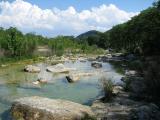Texas Rivers by Cindy Loeffler
The Texas Legislature has taken steps aimed at protecting aquatic ecosystems. In 1997, Senate Bill 1 became law, creating the regional water planning process. Regional water planning groups, which include a nonvoting member from TPWD, prepare 50-year water plans that also consider environmental impacts. The planning groups also have the option of recommending to the Legislature that rivers meeting certain criteria be designated as "ecologically unique," making them off-limits to reservoir construction. Several rivers and streams now have that designation and several more have been nominated. To assist with that process, TPWD staff has compiled information describing ecologically significant rivers and streams for each of the 16 water planning regions. That information can be found here. In 2001, Senate Bill 2 was enacted, directing TPWD, TCEQ and TWDB to determine flow conditions necessary for maintaining healthy rivers and streams. This led to the creation of the interagency Texas Instream Flow Program, which in turn developed study methodologies that have received the seal of approval from the National Academy of Sciences. Instream flow studies to identify flow regimes necessary to protect water quality, provide habitat and maintain channel features including riparian areas are now underway in the Sabine, Trinity, Brazos and San Antonio River Basins. The deadline for study completion is 2016. More information can be found here.
Under the Texas Water Code, entities wishing to divert and use water from Texas rivers must be granted a permit from the TCEQ. Most water rights were issued prior to 1985 and have no environmental protection. Of the estimated 7,500 rights that have been granted, fewer than 15 percent include environmental restrictions to protect streamflows. To address this situation in 2007 the Texas Legislature passed Senate Bill 3 which established a statewide science-based, stakeholder-driven process to protect environmental flows. The Environmental Flows Advisory Group, which includes a member of the TPWD Commission, oversees the process. The Science Advisory Committee provides technical guidance to the science teams appointed for each basin. TPWD staff have and will continue to provide technical expertise to these groups to develop technical guidance and provide support neccesary to identify environmental flow regimes adequate to support a sound ecological environment. To date TCEQ has established environmental flow standards for the Sabine, Neches, Trinity and San Jacinto Basins. More information on the SB3 environmental flows process can be found here.
Streamflow is just one of the factors that can affect a species living in Texas rivers. Texas rivers are taking a beating in the current drought. Texas is now in the midst of its most severe one-year drought on record, according to State Climatologist John Nielsen-Gammon. Preliminary reports from the National Climatic Data Center indicate that July 2011 was the hottest month ever recorded for Texas, with data going back to 1895. US Geological Survey streamflow gages for much of the state are registering well below normal streamflow. Streamflows in some areas are in the 10th percentile or lower range, indicating severe hydrologic drought. Low flows are limiting available habitat for some aquatic species, and producing water quality concerns due to high temperatures and low flow conditions. Information about current drought and streamflow conditions can be accesse at the USGS WaterWatch website. TPWD is keeping an eye on the sky, praying for rain and hoping all of our efforts to protect Texas rivers will be enough as the Drought of 2011 persists.
Cindy Loeffler is Water Resources Branch Chief working out of Austin for the Texas Parks and Wildlife Department.







